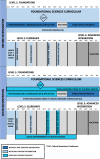The design and implementation of a longitudinal social medicine curriculum at the University of Vermont's Larner College of Medicine
- PMID: 33627097
- PMCID: PMC7903930
- DOI: 10.1186/s12909-021-02533-x
The design and implementation of a longitudinal social medicine curriculum at the University of Vermont's Larner College of Medicine
Erratum in
-
Correction to: The design and implementation of a longitudinal social medicine curriculum at the University of Vermont's Larner College of Medicine.BMC Med Educ. 2021 Mar 10;21(1):154. doi: 10.1186/s12909-021-02594-y. BMC Med Educ. 2021. PMID: 33691675 Free PMC article. No abstract available.
Abstract
Background: Despite an abundant literature advocating that social determinants of health (SDH) be taught during undergraduate medical education, there are few detailed descriptions of how to design and implement longitudinal core curricula that is delivered to all students and accomplishes this goal.
Methods: In this paper, we describe the design and implementation of a social medicine curriculum at the University of Vermont's Larner College of Medicine (UVM Larner). Using Kern's principles, we designed a longitudinal curriculum that extends through both preclinical and clinical training for all students and focused on integrating SDH material directly into basic science and clinical training.
Results: We successfully developed and implemented two primary tools, a "Social Medicine Theme of the Week" (SMTW) in preclinical training, and SDH rounds in the clinical setting to deliver SDH content to all learners at UVM Larner.
Conclusions: Extensive student-faculty partnerships, robust needs assessment, and focusing on longitudinal and integrated SDH content delivery to all students were key features that contributed to successful design and implementation.
Keywords: Clinical medical education; Health care; Health inequities; Medical education; Preclinical medical education; Racism; Social determinants of health; Undergraduate medical education.
Conflict of interest statement
The authors declare that they have no competing interests.
Figures
Similar articles
-
A new roadmap for social medicine curriculum design based on mixed methods student and faculty evaluations of the preclinical curriculum.BMC Med Educ. 2021 Aug 20;21(1):442. doi: 10.1186/s12909-021-02885-4. BMC Med Educ. 2021. PMID: 34416885 Free PMC article.
-
Integrating social determinants of health principles into the preclinical medical curriculum via student-led pedagogical modalities.BMC Med Educ. 2023 Apr 4;23(1):210. doi: 10.1186/s12909-023-04152-0. BMC Med Educ. 2023. PMID: 37016345 Free PMC article.
-
Social Determinants of Health Curriculum Integrated Into a Core Emergency Medicine Clerkship.MedEdPORTAL. 2019 Jan 4;15:10789. doi: 10.15766/mep_2374-8265.10789. MedEdPORTAL. 2019. PMID: 30800989 Free PMC article.
-
Assessment of an integrated curriculum in radiology.Acad Med. 2002 Sep;77(9):933. doi: 10.1097/00001888-200209000-00037. Acad Med. 2002. PMID: 12228105 Review.
-
Teaching the Social Determinants of Health in Undergraduate Medical Education: a Scoping Review.J Gen Intern Med. 2019 May;34(5):720-730. doi: 10.1007/s11606-019-04876-0. J Gen Intern Med. 2019. PMID: 30993619 Free PMC article.
Cited by
-
Conceptualization and teaching health advocacy in undergraduate medical education: a document analysis.BMC Med Educ. 2024 Sep 28;24(1):1064. doi: 10.1186/s12909-024-06039-0. BMC Med Educ. 2024. PMID: 39342200 Free PMC article.
-
A new roadmap for social medicine curriculum design based on mixed methods student and faculty evaluations of the preclinical curriculum.BMC Med Educ. 2021 Aug 20;21(1):442. doi: 10.1186/s12909-021-02885-4. BMC Med Educ. 2021. PMID: 34416885 Free PMC article.
-
Framework for implementing asylum seekers and refugees' health into the undergraduate medical curriculum in the United Kingdom.Health Educ Res. 2024 Mar 20;39(2):170-181. doi: 10.1093/her/cyae002. Health Educ Res. 2024. PMID: 38295307 Free PMC article. Review.
-
Beyond the Basics: A Novel Approach to Integrating a Social Determinants of Health Curriculum into an Emergency Medicine Course.West J Emerg Med. 2023 Nov;24(6):1094-1103. doi: 10.5811/westjem.59797. West J Emerg Med. 2023. PMID: 38165192 Free PMC article.
-
Correction to: The design and implementation of a longitudinal social medicine curriculum at the University of Vermont's Larner College of Medicine.BMC Med Educ. 2021 Mar 10;21(1):154. doi: 10.1186/s12909-021-02594-y. BMC Med Educ. 2021. PMID: 33691675 Free PMC article. No abstract available.
References
-
- CDC. Social determinants of health: know what affects health: sources for data on SDOH. CDC. https://www.cdc.gov/socialdeterminants/data/index.htm. Accessed 16 Feb 2021.
-
- WHO. Social determinants of health. WHO. https://www.who.int/social_determinants/en/. Accessed 16 Feb 2021.
MeSH terms
LinkOut - more resources
Full Text Sources
Other Literature Sources


